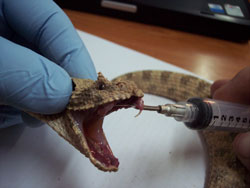From Devils to Darlings: How we use Venoms, Toxins and Nanotechnology to Save Lives
News category: Newnano
 The sight of a snake on the porch or a spider in the bathroom is enough to send most people running for the hills, but scientists have managed to stick around long enough to utilise the creepy crawler’s greatest scare tactic: venom. In the near future these otherwise-lethal substances could be harnessed to cure and treat humanity’s most feared diseases.
The sight of a snake on the porch or a spider in the bathroom is enough to send most people running for the hills, but scientists have managed to stick around long enough to utilise the creepy crawler’s greatest scare tactic: venom. In the near future these otherwise-lethal substances could be harnessed to cure and treat humanity’s most feared diseases.
Venoms are deadly cocktails of several chemicals which certain snakes, spiders, molluscs, insects, plants and even certain mammals use to defend themselves and use to catch prey by injecting it into their victim. A toxin or poison, on the other hand, must be ingested to cause harm. Venomous concoctions are capable of melting the victim’s muscles, curdling their blood to cause heart failure, and even suffocating the victim by immobilising their nervous system. Accordingly, venoms have been considered lethal substances to be feared and avoided. Globally, there are roughly 725 species of venomous snakes, 1 500 scorpions and 37 000 known species of spider capable of harming humans, with Africa, including South Africa, having some of the most deadly snakes in the world. Envenomation, or the act of an animal biting and injecting venom into a victim, is a global public health issue as venomous creatures are found on every continent and almost every country. Bee, wasp, ant, spider, scorpion, millipede and centipede stings make up the most common cause of envenomation by animals, although 80% of deaths by envenomation are caused by snake bites. South Africa’s spiders aren’t to be messed with either, for the most common venomous spider in South Africa, the violin spider, has no antivenom. Nevertheless, although venoms are fearsome adversaries, they have many positive qualities besides, such as being very tough and capable of surviving in almost any environment, making them ideal for medical drug development.
The venom from a particularly deadly snake, the Brazilian viper, has been incorporated into the daily use of millions of individuals suffering from renovascular hypertension – high blood pressure caused by faulty kidneys. The drug Captopril®, developed by three US scientists 38 years ago, is an angiotensin-converting enzyme (ACE)-inhibiting drug which was isolated from the viper Bothrops jararaca; its venom suppresses the hormone responsible for the aforementioned kidney defect, affording the person a healthier life.
Worldwide, researchers have identified numerous venoms with medical properties, but these molecules need to be utilized in a specific manner for maximum effect and minimum harm. It is in this tiny area of necessity, that nanotechnology has found its niche.
Nanoparticles such as nano-gold, nano-silver, magnetic nano-iron and the tree-shaped dendrimers have been intensely studied for their potential use as venom drug delivery vehicles. Bombesin, a toxin found on the skin of the European fire-bellied toad, attached to gold nanoparticles naturally affixes to prostate, breast and lung cancer tumours, force their way in and cause the tumours to shrivel and die. Furthermore multiple sclerosis (a disease wherein the immune system attacks a person’s brain and spinal cord) is a large and growing problem in South Africa, but has now been presented with a potential treatment: scorpion venom from the United States. This venom, delivered by nanomaterials, will serve to block receptors which cause the immune system to attack. Also, venom from the green mamba, one of South Africa’s most feared and beautiful snakes, is currently being specially made along with nanomaterials for its use as a pain killer.
Considering all of the possible applications of venoms, and South Africa’s large pool of venomous creatures, it has become time to re-evaluate what we think of as deadly, venomous creatures and what danger they really pose to us. Due to South Africa’s great wealth of venomous creatures perhaps a new export will arise, one that could save millions of lives.
Writer: Janske Nel
